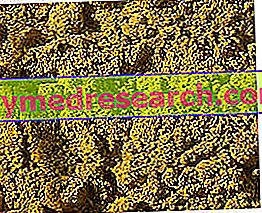Generality
Hemp seed flour - more simply called hemp flour - is a food obtained from the grinding of the seeds of Cannabis sativa L.

Hemp seed flour is a "dough" ingredient, which can be very useful in the diet against celiac disease. It is also appreciated for the nutritional content of molecules useful to the body, such as essential fatty acids, fibers, vitamins and certain amino acids.
Hemp flour is a product in its own right and differs both from the waste produced by hemp milk (called okara ) and from the decortication waste of whole seeds. Moreover, despite being obtained by processing the so-called panel (what remains from the pressing of the seeds by extraction of the oil), the two terms cannot be considered "synonyms".
The hemp food products currently available on the market are: whole hemp seeds, shelled hemp seeds, hemp seed oil, hemp seed milk (Hemp milk), hemp drinks (Hemp drink), seed tofu hemp, hemp okara and hemp protein flour (50% protein).
Nutritional intake
Hemp flour is a food that provides over 21% fewer calories than the more well-known type 00 wheat flour. These calories are also distributed differently, since in the hemp flour as much as 49.5% of the energy comes from proteins (prevailing energy nutrient), while in wheat type 00, 89% of calories is supplied by complex carbohydrates.
The proteins of hemp seed flour do not include gliadin and glutenin (therefore gluten), so the food is perfectly tolerated by celiacs.
The main peptide component - called edestine (typical of legumes) - contributes prevalently to the total protein intake, equal to about 30% of the total mass.
Peptides appear to have a medium-high biological value, since they provide (in significant quantities) all the essential amino acids. In this regard, in the vegan diet, the consumption of hemp flour should be frequent and systematic, ideally alternated with that of soy flour.
Among the various amino acids contained in it, the significant contribution of arginine intrigues, while lysine can be considered the limiting amino acid.
The digestibility (PDCAAS) of hemp flour proteins is comparable (or superior) to that of some cereals, legumes (for example soy) and achenes (in fact called dried fruit). The essential amino acids of hemp flour (except lysine and sulfur dioxide) satisfy the contributions recommended by the FAO / WHO (Food and Agriculture Organization - World Health Organization) required for children aged between 2 and 5 years.
Hemp flour also contains a large proportion of triglycerides. These, mainly composed of essential polyunsaturated fatty acids, represent 24% of total calories and just over 8% of total weight. What astounds is not so much the absolute value of essential fatty acids as the optimal ratio of 2: 1 or 3: 1 between omega 6 and omega3. Thanks to this characteristic, hemp flour (but above all hemp oil) is considered a preventive food against many cardio-vascular discomforts with metabolic etiopathogenesis.
In contrast to the type 00 wheat flour, hemp seed flour provides only 3.8% of the calories from carbohydrates, which are simple sugars and not long polymers.
The fibers are very abundant and make it an ideal food for fighting or preventing constipation.
The most present mineral salts are: potassium, magnesium, iron and zinc, while as far as vitamins are concerned, tocopherols (vit. E) stand out above all.
The table below summarizes the quantitatively most important nutritional molecules of hemp seed flour.
| Nutritional Composition of Hemp Flour | ||
Power | 303kcal / 1253kj | |
Protein | 29, 90g | |
Carbohydrates | 3, 10g | |
of which simple sugars | 3, 10g | |
Grassi | 8, 10g | |
of which saturated | 0, 87g | |
Dietary fiber | 49, 00g | |
Sodium | 7, 00mg | |
Production, Features and Usage
As anticipated, hemp flour is produced by grinding and sieving what is left over after pressing for oil extraction.
Being a "philonaturista" food, the commercially available hemp flour is almost exclusively declared by organic farming and has a cost of around € 25 per kilogram.
It can be considered a "raw" food, which is why it is also consumed by many followers of "raw food". On the other hand, this peculiarity (associated with high lipid content) requires a certain care of the preservation method which, when sealed and vacuum packed, requires a temperature lower than 42 ° C; with open packaging, on the other hand, the shelf life is further reduced and requires a rather low humidity rate.
Hemp seed flour is also included in the so-called Kosher foods, ie those that respect the religious food restrictions imposed on observant Jews.
Hemp flour has a flavor very similar to that of hazelnut and can be used for baking, for muffins, for biscuits, for milk (bliss), etc. It is often used by vegans (but not only) to increase the protein intake of bakery products, partially replacing it with wheat flour in a variable amount between 10 and 25%.
For examples of culinary applications of hemp flour, see the "Alice Recipes Video" section.
Hemp flour cookies
X Problems with video playback? Reload from YouTube Go to Video Page Go to Video Recipes Section Watch the video on youtubeBibliography
- Physico-chemical and functional properties of isolated hemp proteins (Cannabis sativa L. ) - Tang CH1, Ten Z, Wang XS, Yang XQ. - J Agric Food Chem. 2006 Nov 15; 54 (23): 8945-50.
- Evaluating the quality of protein from hemp seed (Cannabis sativa L. ) products through the use of the protein digestibility-corrected amino acid score method - House JD1, Neufeld J, Leson G. - J Agric Food Chem. 2010 Nov 24; 58 (22): 11801-7. doi: 10.1021 / jf102636b. Epub 2010 Oct 26.



